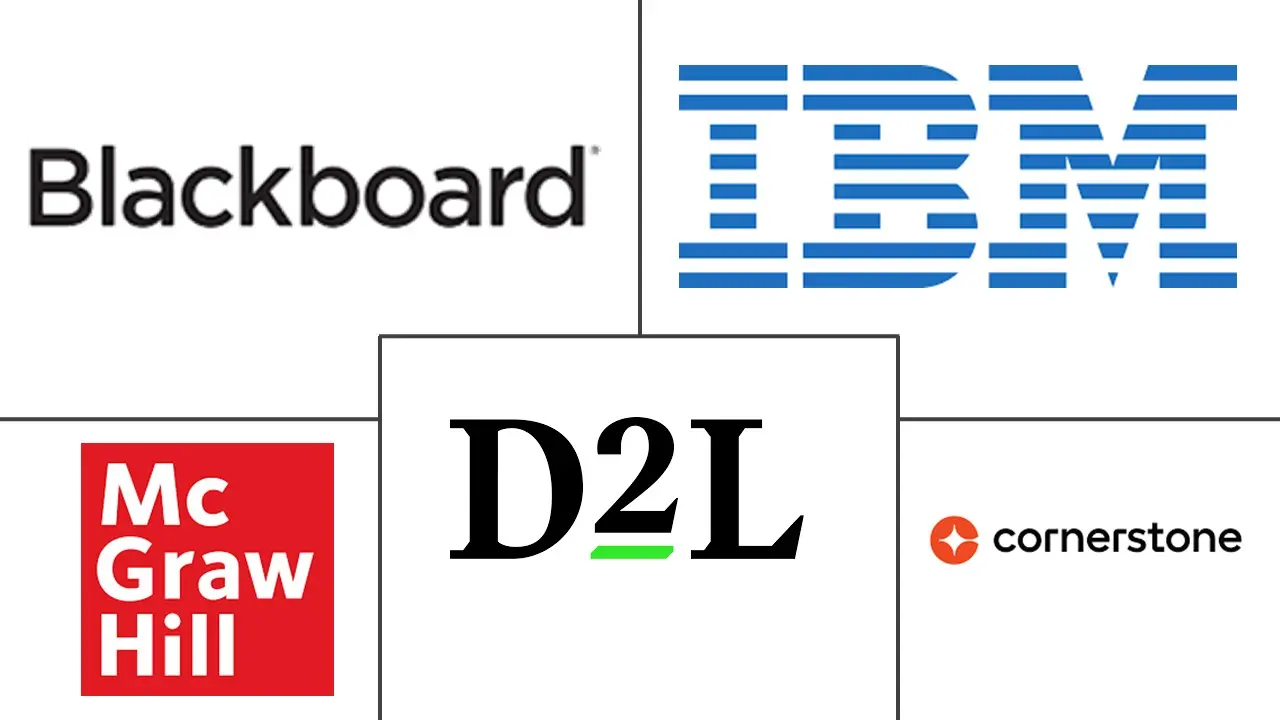Learning Management System (LMS) Market Size and Share
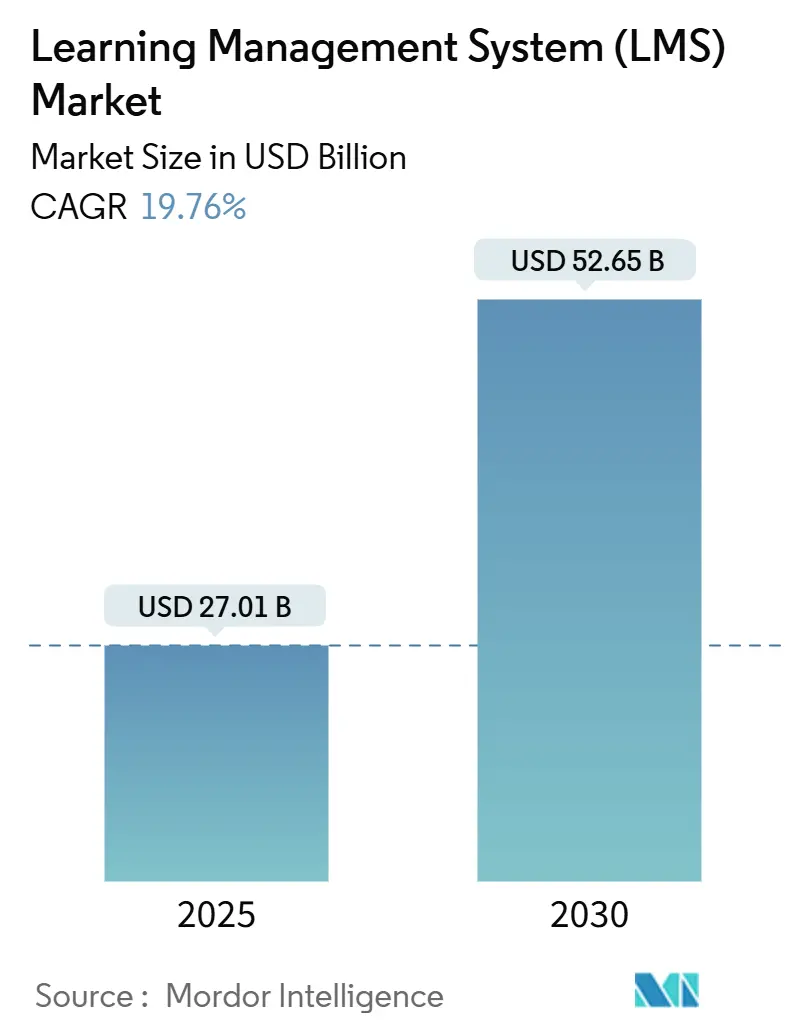
Learning Management System (LMS) Market Analysis by Mordor Intelligence
The learning management system market is valued at USD 27.01 billion in 2025 and is forecast to climb to USD 52.65 billion by 2030, advancing at a 19.76% CAGR. Enterprises across sectors are investing in AI-powered personalization, micro-credentialing, and mobile learning to keep workforce skills current while meeting increasingly complex compliance mandates. North American healthcare and financial-services organizations remain early adopters, yet Asia-Pacific manufacturing hubs now drive incremental demand by linking digital learning to measurable productivity gains. Technology vendors are responding with predictive analytics, granular skills verification, and low-code integration to embed training into daily workflows. At the same time, rising SaaS licensing fees and last-mile connectivity gaps restrain budget-sensitive segments, forcing vendors to refine pricing tiers and content-delivery optimization.
Key Report Takeaways
- By component, Solutions captured 67% of the learning management system market share in 2024, while Services are projected to grow at 21.3% CAGR through 2030.
- By deployment mode, Cloud platforms commanded 70% share of the learning management system market size in 2024 and are expanding at a 22.8% CAGR between 2025 and 2030.
- By delivery mode, Distance Learning held 55% of the learning management system market size in 2024; Blended Learning is set to record the fastest 24.1% CAGR to 2030.
- By end-user vertical, Educational Institutions led with 32% revenue share in 2024, whereas Healthcare & Pharmaceuticals will register the highest 20.8% CAGR through 2030.
- By geography, North America accounted for 36% of the learning management system market share in 2024; Asia-Pacific is on track for a 24.5% CAGR to 2030.
Global Learning Management System (LMS) Market Trends and Insights
Drivers Impact Analysis
| Driver | (~) % Impact on CAGR Forecast | Geographic Relevance | Impact Timeline |
|---|---|---|---|
| Integration of AI-driven adaptive learning algorithms boosting course-completion rates in North American higher-education | +4.2% | North America, with spillover to Europe and APAC | Medium term (2-4 years) |
| Employer demand for skills-verification micro-credentials fueling LMS uptake across APAC manufacturing hubs | +3.8% | APAC core, with expansion to manufacturing regions globally | Long term (≥ 4 years) |
| Mandatory CPD regulations in EU healthcare catalyzing specialised LMS modules | +2.1% | Europe, with regulatory influence spreading to other regions | Short term (≤ 2 years) |
| BYOD workforce mobility in distributed retail chains accelerating mobile-first cloud LMS adoption in Middle East | +1.9% | Middle East & GCC, with retail sector adoption globally | Medium term (2-4 years) |
| Source: Mordor Intelligence | |||
AI-Driven Adaptive Learning Algorithms Transform Course Completion Dynamics
AI-powered adaptive systems now tailor difficulty, pacing, and feedback in real time, delivering 40% higher course-completion rates for pilot programs in North American universities.[1]SafetyCulture Editorial Team, “Adaptive Learning Platforms Guide,” safetyculture.com Algorithms analyse time-on-task, assessment scores, and click-stream data to forecast disengagement and trigger targeted interventions that keep learners on track. Enterprises mirror this practice to reduce onboarding time and raise certification pass rates, tying learning objectives directly to key-performance indicators. Vendors that embed explainable AI build credibility with educators who must defend algorithmic decisions during accreditation audits. As feature sets mature, customers expect plug-and-play recommendation engines rather than bespoke data-science projects, simplifying adoption for mid-market buyers.
Micro-Credentials Drive Skills-Based Hiring Revolution
Asia-Pacific manufacturers face rapid automation cycles and therefore favour bite-sized certifications that prove competence in robotics, quality control, and supply-chain analytics. Surveys show 86% of employers rate micro-credentials as beneficial when evaluating applicants; workers progressively stack these badges to create dynamic skill portfolios. Blockchain verification ensures tamper-proof records that hiring managers can authenticate instantly, shortening recruitment cycles. As evidence of impact spreads, professional associations in North America begin mapping badges to continuing-education credits, extending the credentialing model into regulated professions.
European Healthcare CPD Regulations Mandate Specialized Training Modules
EU directives require physicians, nurses, and allied health professionals to document ongoing learning with audit-ready precision. Hospitals now deploy LMS modules that link evidence-based courseware to license-renewal dashboards, reducing manual paperwork while improving regulatory readiness.[2]Wolters Kluwer Health Editorial, “Continuing Professional Development Requirements,” wolterskluwer.com Vendors collaborate with accreditation bodies to pre-approve curricula, accelerating hospital procurement decisions. Feature roadmaps prioritise multilingual content, offline mobile access for shift workers, and real-time competency gap analysis that feeds workforce-planning tools.
BYOD Workforce Mobility Accelerates Mobile-First LMS Architecture
Retail organisations with dispersed store networks demand micro-learning that runs smoothly on diverse smartphones, especially in GCC markets where smartphone adoption eclipses PC ownership.[3]5G Store Research, “Rural Connectivity Technology Overview,” 5gstore.com Cloud LMS vendors optimise app footprints, offer offline sync, and compress media to overcome patchy connectivity. Store associates can access product updates between customer interactions, driving measurable uplift in upsell rates and compliance adherence. Integration with mobile point-of-sale systems promises context-aware training that triggers just-in-time modules based on scanned SKUs, reinforcing knowledge at the moment of need.
Restraints Impact Analysis
| Restraint | (~) % Impact on CAGR Forecast | Geographic Relevance | Impact Timeline |
|---|---|---|---|
| Rising per-learner SaaS-licensing inflation squeezing budgets of K-12 districts | -2.3% | North America and Europe, with budget pressure in public education globally | Short term (≤ 2 years) |
| Patchy 5G / broadband coverage limiting immersive-content delivery in rural Africa & South Asia | -1.8% | Rural regions in Africa and South Asia, with infrastructure gaps globally | Long term (≥ 4 years) |
| Fragmented data standards hindering HRIS-LMS integrations in legacy-heavy European corporates | -1.5% | Europe, with legacy system challenges in mature markets globally | Medium term (2-4 years) |
| Escalating cyber-insurance premiums post-ransomware attacks deterring small healthcare providers from cloud LMS migration | -1.2% | Global, with particular impact on small healthcare providers in developed markets | Short term (≤ 2 years) |
| Source: Mordor Intelligence | |||
SaaS Licensing Cost Inflation Pressures Educational Budgets
Recurring per-learner fees escalate as pandemic relief subsidies taper, forcing K-12 districts to reassess multi-year LMS contracts. Districts with 20,000 students report annual renewals rising 14% in 2025, outpacing stagnant operating budgets. Some pivot to open-source alternatives yet discover hidden costs in self-hosting and maintenance, highlighting a trade-off between cash outlay and administrative burden. Vendors respond with tiered pricing tied to active user metrics, but transparency remains inconsistent, prolonging procurement cycles.
Infrastructure Limitations Constrain Immersive Learning Delivery
Only 48% of rural households worldwide possess internet access, compared with 83% in urban zones, and 5G covers just 4% of low-income countries. Bandwidth-intensive VR simulations stall on 3G networks, undermining planned rollouts in vocational programmes aimed at agriculture and mining workers. LMS providers invest in adaptive streaming and offline caching, yet content-authoring teams must duplicate assets at multiple resolution tiers, increasing production costs. Until last-mile infrastructure improves, immersive modalities remain an aspirational feature for many emerging-market buyers.
Segment Analysis
By Component: Services Gain Momentum as Platforms Mature
Solutions generated a dominant 67% revenue share in 2024, underscoring the centrality of platform licences in the learning management system market. The Services segment, however, is racing ahead at a 21.3% CAGR. Organisations that have already deployed a core platform now seek instructional-design support, system integration, and analytics optimisation. Case studies show that supply-chain firms achieved 30% faster course development after outsourcing content mapping to specialist agencies. As AI features proliferate, in-house teams require guidance to calibrate algorithms, opening new revenue pools for professional-services providers. The learning management system market size for Services is projected to rise from USD 8.11 billion in 2025 to USD 21.2 billion by 2030.
The Solutions segment is hardly static. Vendors are layering low-code workflow builders, API marketplaces, and native video-production suites to stave off commoditisation. Larger buyers negotiate enterprise-wide contracts that bundle multiple modules—authoring, credentialing, and advanced analytics—into predictable subscription envelopes. Smaller vendors differentiate through vertical templates that ship with compliance libraries for health and manufacturing domains. Consequently, procurement teams now evaluate total cost of ownership over five-year horizons rather than headline licence fees, a shift that benefits suppliers able to present robust ecosystem roadmaps.
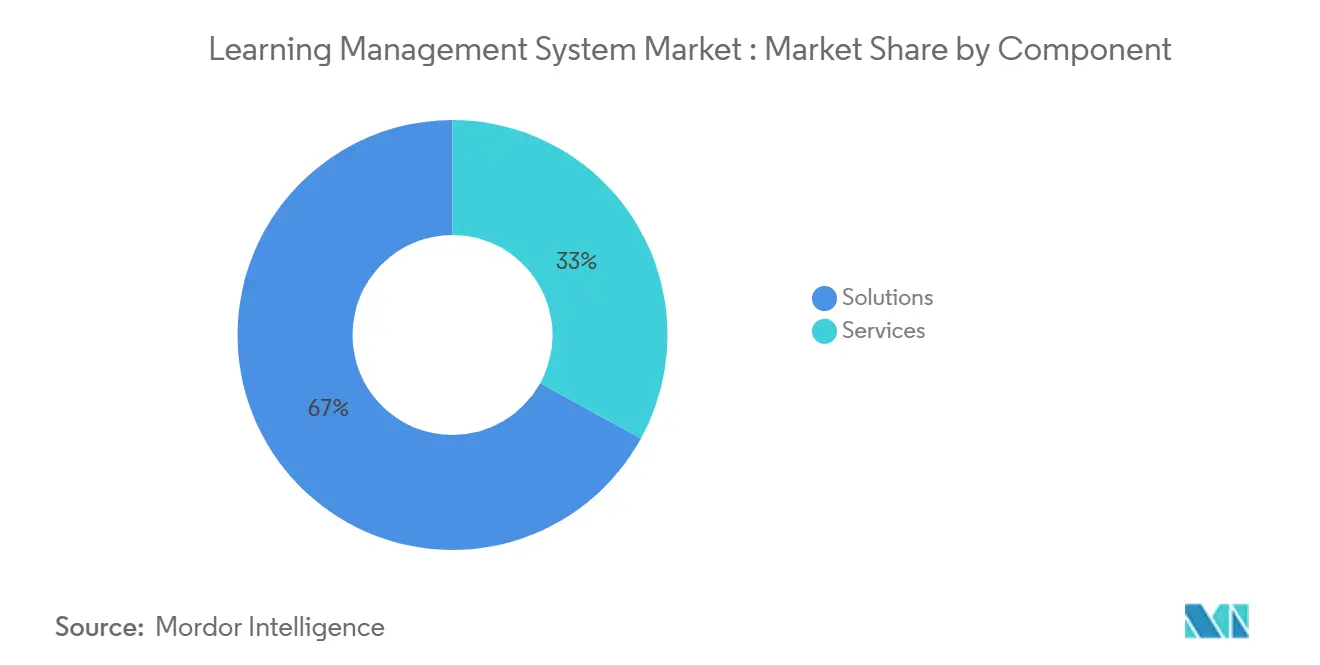
By Deployment Mode: Cloud Consolidates Leadership Position
Cloud architectures held 70% share of total learning management system market revenue in 2024 and continue to expand at 22.8% CAGR. Buyers cite automatic security patches, elastic scaling, and reduced IT overhead as decisive factors. Multinational firms further value region-specific data-residency options that simplify privacy compliance in Europe and Asia. The learning management system market size for cloud deployments is poised to climb from USD 18.9 billion in 2025 to USD 43.4 billion by 2030, underscoring an accelerating on-premise migration wave.
On-premise implementations persist in defence, energy, and public-sector accounts where air-gapped environments mitigate espionage risks. Even these organisations increasingly test private-cloud pilots to modernise user experience and analytics. Vendors thus support hybrid architectures that synchronise content repositories while retaining sensitive assessment data on local servers. Marketplace momentum nevertheless favours pure-cloud disruptors that release new features monthly, outpacing annual upgrade cycles typical of legacy suites.
By Delivery Mode: Blended Learning Emerges as Pedagogical Sweet Spot
Distance Learning captured 55% of learning management system market revenue in 2024, a legacy of pandemic-era remote-instruction mandates. Yet Blended Learning, combining digital modules with instructor-led sessions, is forecast to post the highest 24.1% CAGR through 2030. Organisations report superior knowledge retention when learners complete pre-work online, apply concepts in live workshops, and reinforce proficiency via micro-learning nudges. The learning management system market share for Blended Learning is expected to grow from 22% in 2025 to 31% by 2030.
Instructor-led Training remains vital for complex, hands-on scenarios such as equipment maintenance or surgical procedures. Modern platforms integrate webinar tools, AR overlays, and attendance analytics to digitise facets of classroom delivery, ensuring that even face-to-face sessions feed comprehensive learner-record dashboards. Vendors that streamline scheduling, resource allocation, and competency tracking across hybrid journeys win favour with learning leaders who manage increasingly distributed talent pools.
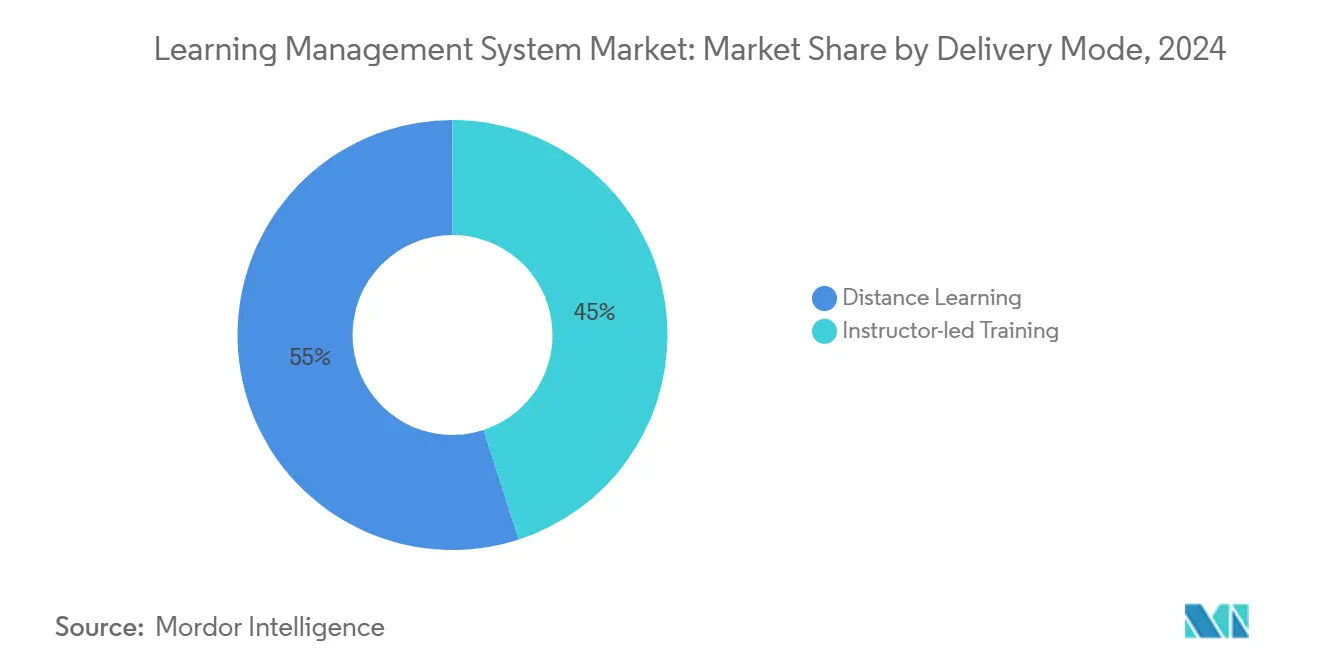
By End-User Vertical: Healthcare Outpaces Education in Growth
Educational Institutions still account for the largest customer block, generating 32% of sector revenue in 2024. However, the healthcare and pharmaceutical domain is projected to log the fastest 20.8% CAGR as regulators intensify oversight of clinical competencies. Hospitals leverage LMS analytics to tie training completion directly to patient-safety metrics, elevating the platform from HR system to board-level tool. The learning management system industry also sees life-sciences firms linking regulatory training to electronic batch records, reducing batch-release cycle time by up to two days.
BFSI organisations accelerate investment to meet anti-money-laundering training thresholds across dispersed branch networks. Manufacturing clients embed safety, quality, and lean-manufacturing modules into daily shift-handover routines. Retail chains deploy nano-learning clips that boost customer-satisfaction scores by standardising service scripts across thousands of outlets. Government agencies continue to rely on LMS solutions for policy-compliance rollouts, though procurement cycles lengthen due to public-tender regulations.
Geography Analysis
North America generated 36% of global revenue in 2024, supported by advanced connectivity, high SaaS readiness, and stringent compliance frameworks across healthcare and finance. Large enterprises now focus on AI-driven optimisation rather than first-time deployment, spurring demand for predictive talent analytics add-ons. Federal and state grants targeting workforce reskilling further buoy platform adoption in community colleges and veteran-training programmes. Nevertheless, budget scrutiny in K-12 districts tempers short-term growth until funding models stabilise.
Asia-Pacific is projected to grow at 24.5% CAGR through 2030, propelled by India’s Digital India programme and China’s Made in China 2025 policy, both of which tie industrial modernisation to workforce upskilling. Multinational manufacturers mandate uniform training standards across regional plants, creating cross-border LMS rollouts that reward vendors with localisation expertise. Banking digitalisation across ASEAN markets further drives compliance-training licences. Still, linguistic diversity and varied data-privacy statutes necessitate modular deployment strategies.
Europe exhibits stable expansion as GDPR compliance and CPD rules fuel demand for platforms with granular audit trails. Governments fund digital apprenticeships that rely on LMS scaffolding, while corporations integrate learning suites with talent-management systems to address demographic skill shortages. The Middle East experiences above-average growth in GCC economies where national-transformation agendas prioritise digital skills. Africa shows uneven progress; urban centres adopt cloud LMS rapidly whereas rural districts lag due to connectivity challenges.
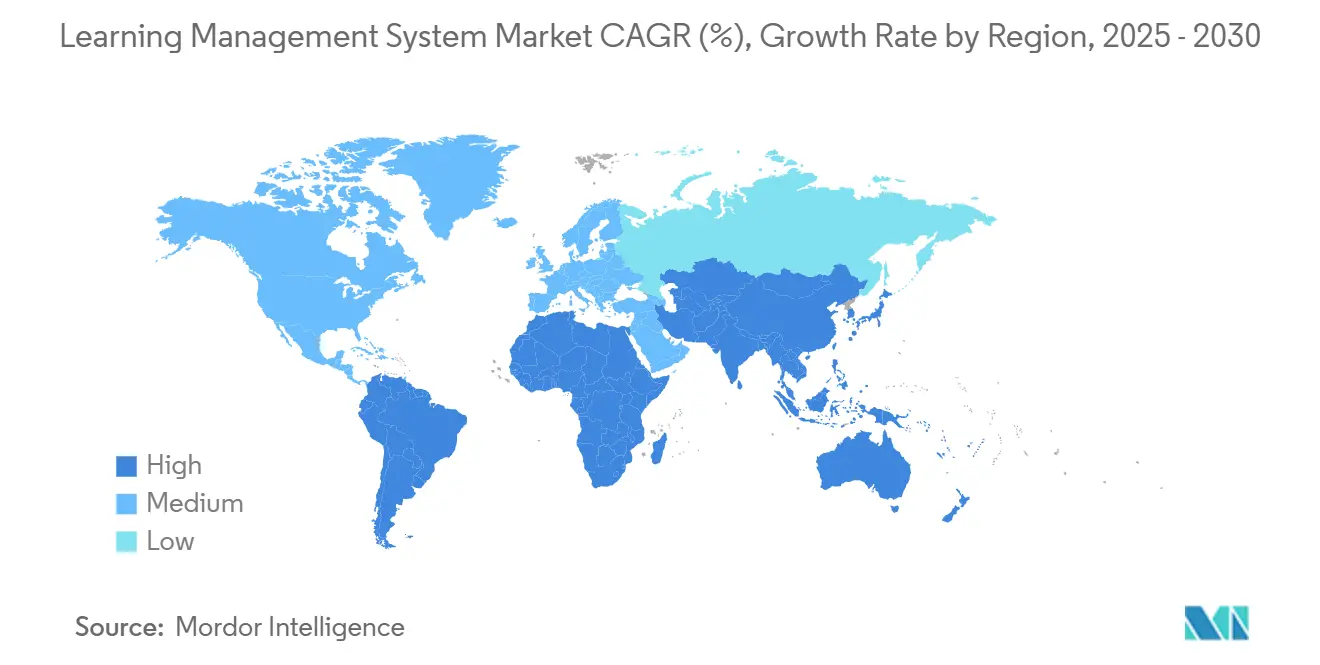
Competitive Landscape
Market concentration is moderate. Tier-one vendors such as Instructure, Cornerstone, and SAP SuccessFactors leverage acquisitions to broaden functionality and lock in enterprise clients. Docebo, for instance, delivered USD 216.9 million in 2024 revenue on the back of a “land-and-expand” strategy that cross-sells content libraries and analytics to existing accounts. Private-equity interest reached a peak with the USD 4.8 billion take-private of Instructure, giving the company capital to accelerate AI and credential-management roadmaps.
Challenger brands target narrow verticals—healthcare, manufacturing, public safety—where domain-specific features trump generalist breadth. Partnerships with content publishers and credential-issuers create ecosystem advantage that outweighs raw platform functionality. Competition increasingly centres on integration maturity. Buyers evaluate how seamlessly an LMS interacts with HRIS, CRM, and ERP suites, pushing vendors to expose open APIs and pre-built connectors. Mobile design, offline capability, and adaptive-learning sophistication now define table stakes rather than differentiators.
Vendor pricing models shift toward consumption-based tiers to counter budget objections. Some suppliers unbundle analytics and credential-management modules into optional add-ons, enabling entry-level adoption while preserving upsell headroom. Meanwhile, open-source frameworks win niche deployments where organisations possess strong internal IT, but commercial vendors respond by offering managed-cloud hosting for leading open-source stacks, blurring traditional boundaries between proprietary and community solutions.
Learning Management System (LMS) Industry Leaders
-
Blackboard, Inc.
-
Cornerstone OnDemand, Inc.
-
D2L Corporation
-
IBM Corporation
-
McGraw-Hill Companies
- *Disclaimer: Major Players sorted in no particular order

Recent Industry Developments
- February 2025: Cornerstone secured an enterprise roll-out with UK retailer Kingfisher to standardize employee development across 80,000 staff in Europe through the Cornerstone Galaxy platform.
- February 2025: Docebo acquired Hong Kong–based Edugo AI for USD 6.2 million to accelerate conversational-AI capabilities inside its corporate LMS portfolio.
- January 2025: LearnUpon joined forces with customer-success platform Planhat to integrate learning data with customer health metrics, aiming to deepen post-sale engagement for SaaS vendors.
- January 2025: Cornerstone OnDemand and analytics specialist Visier unveiled a strategic relationship that will embed advanced workforce analytics natively inside Cornerstone’s learning suite, giving HR teams richer insights into skill gaps and program ROI.
Research Methodology Framework and Report Scope
Market Definitions and Key Coverage
Our study defines the learning management system (LMS) market as all revenue earned from commercially licensed software that creates, delivers, manages, and reports digital learning for academic, corporate, and public-sector users, whatever the deployment model. According to Mordor Intelligence, license sales, recurring subscriptions, and linked support fees are fully counted.
Scope Exclusions: stand-alone content authoring suites, bespoke in-house portals not sold commercially, and generic video-conferencing tools are excluded.
Segmentation Overview
- By Component
- Solutions
- Services
- By Deployment Mode
- Cloud
- On-premise
- By Delivery Mode
- Distance Learning
- Instructor-led Training
- By End-user Vertical
- BFSI
- Healthcare and Pharmaceuticals
- Manufacturing
- Retail and Consumer Goods
- Educational Institutions
- Government Agencies
- Other End-user Verticals
- By Geography
- North America
- United States
- Canada
- Mexico
- Europe
- United Kingdom
- France
- Germany
- Nordics
- Rest of Europe
- Asia-Pacific
- China
- India
- Japan
- South Korea
- Rest of Asia-Pacific
- South America
- Brazil
- Mexico
- Rest of South America
- Middle East
- GCC
- Turkey
- Rest of Middle East
- Africa
- South Africa
- Nigeria
- Rest of Africa
- North America
Detailed Research Methodology and Data Validation
Primary Research
We interviewed product managers at LMS suppliers, learning and development heads across North America, Europe, and Asia, and administrators from higher education consortia. Their insights on seat pricing, cloud shift, and service attachment rates closed data gaps and validated desk assumptions.
Desk Research
Mordor analysts first mapped active LMS vendors with UNESCO's ICT in Education portal, US NCES IT spend files, and European Commission digital learning dashboards. They then enriched vendor rolls and price corridors with patent sets from Questel plus adoption clues found in D&B Hoovers, Dow Jones Factiva, and public filings. A second sweep used World Bank data, OECD Education at a Glance tables, and telecom regulator statistics to translate learner counts and seat prices into addressable revenue pools. The sources named are illustrative; many additional open documents informed the desk work.
Market-Sizing & Forecasting
A top-down build rooted in education and enterprise IT outlays is balanced with selective bottom-up vendor samples to anchor the base value. Key variables include online learner enrollments, training spend per employee, cloud penetration, average subscription ARPU, AI feature uptake, and currency shifts. Five-year forecasts rely on multivariate regression blended with scenario analysis; bottom-up variances beyond one standard deviation are trimmed before lock-in.
Data Validation & Update Cycle
Outputs pass three analyst reviews and anomaly checks against fresh earnings releases. Reports refresh annually, with interim updates triggered by major mergers or policy shifts, ensuring clients receive the latest view.
Why Mordor's Learning Management System Baseline Commands Reliability
Published values differ because firms apply varied revenue buckets, exchange methods, and refresh cadences.
Our disciplined scope alignment and yearly resurveying keep figures stable yet current.
Benchmark comparison
| Market Size | Anonymized source | Primary gap driver |
|---|---|---|
| USD 27.01 B (2025) | Mordor Intelligence | - |
| USD 22.10 B (2023) | Global Consultancy A | Excludes services; older base year |
| USD 28.58 B (2025) | Industry Journal B | Bundles stand-alone portals |
| USD 26.76 B (2024) | Trade Journal C | Spot exchange rate, not yearly average |
These contrasts show that our transparent variable set, multi-step reviews, and timely refresh cycle deliver a balanced baseline decision makers can trust.
Key Questions Answered in the Report
What is the current size of the learning management system market?
The market stands at USD 27.01 billion in 2025 and is projected to hit USD 52.65 billion by 2030.
Which region is growing fastest?
Asia-Pacific is expanding at a 24.5% CAGR, driven by government digitisation programmes and manufacturing upskilling initiatives.
Why are services growing faster than platform licences?
As organisations mature, they need instructional design, system integration, and analytics optimisation, pushing Services to a 21.3% CAGR through 2030.
How does AI improve learning outcomes?
Adaptive algorithms personalise pacing and content, raising course-completion rates by up to 40% in documented pilots.
What challenges limit adoption in rural markets?
Patchy broadband and 5G coverage restrict immersive content delivery, reducing the effectiveness of advanced LMS features.
Which vertical will post the fastest growth?
Healthcare & Pharmaceuticals are forecast to record a 20.8% CAGR due to strict CPD and compliance requirements.
Page last updated on:
